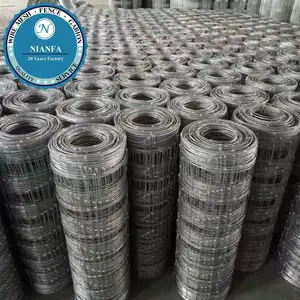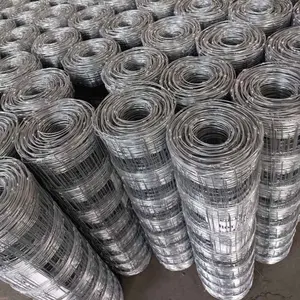(7083 products available)






















































































































































































































The mesh fences have different types based on the material used. These types vary in durability, maintenance, and appearance and provide options for users to choose as per their needs and preferences.
Galvanized mesh fence
Galvanized mesh fences are made from steel wires coated with zinc to protect against corrosion. The fence is strong and durable and is commonly used in areas with weather elements. They provide a barrier for animals and can be used in construction sites, gardens, and schools.
PVC coated mesh fence
The PVC-coated mesh fences have a coating of polyvinyl chloride on the galvanized steel wires. The coating provides additional protection and comes in various colors, giving the fence an appealing look. They are used in wildlife parks, residential areas, and schools.
Stainless steel mesh fence
These kinds of fences are made using stainless steel, which is resistant to rust and corrosion. They are suitable for areas that require cleanliness and have high temperatures and humidity.
Welded wire mesh fence
Hinge-jointed fence mesh can be made from welded wire mesh. The welded mesh is created by welding the intersecting wires together, forming a rigid and uniform structure. The welded wire mesh provides a smooth surface and is used for various applications.
Electrified mesh fence
These are mesh fences with an electrical current running through them. They are mainly used in farms to keep large animals within and to create security fences in high-risk areas. They can also be used in wildlife management areas.
Knots
The knots are woven together to form a diamond shape. Depending on the type of fence, the mesh can be woven into a straight or zigzag pattern.
Materials
Hinge jointed fences are made of wire. The wires can be made of different materials, including steel, galvanized coating, and PVC coating. The galvanized coating is made of zinc and iron to promote rusting. Steel wires are malleable and can be forged into complex shapes. PVC is a polymer of vinyl chloride. It is used to make durable and waterproof fences.
Joint
The joints are linked together to form a roll. Each joint has a tension that determines how taut the fence will be when it is installed. The higher the tension, the more tight the fence will be.
Roll size
Roll sizes are different for each fence. The mesh roll can either be 50, 60, or 72 inches wide. The height of the fence determines the roll size. A taller fence will have a bigger roll size, while a smaller fence will have a compact roll size.
Color
The color of the fence can be an important design consideration, especially when the fence is used for decorative purposes. Hinge jointed mesh can either be coated with PVC in different colors or galvanized and painted with different colors. The color options for galvanized fences are limited to the color of the galvanization coating.
Gauge size
Some hinge jointed mesh fences have a fence liner. The liner can have a different gauge size from the mesh. The gauge size can be small, medium, or large, depending on the purpose of the fence. Larger gauges have bigger spacing, while smaller gauges have tighter spacing.
Diamond size
The mesh can have small, medium, or large diamonds. The diamond size determines the fence's purpose. A fence with a larger diamond mesh may be used in areas with less security risks.
Hinge jointed fencing is a versatile and practical fencing solution. It has many applications across different industries. These uses show how well the fence meets different needs. It makes them secure, durable, and easy to maintain.
Construction sites
Hinge jointed fence mesh is used to secure construction sites. It keeps large equipment and construction materials safe. It also keeps people out of dangerous work areas.
Agricultural fields
Farmers use this fence to protect crops from animals. It also helps to create enclosures for livestock and to manage pastures.
Wildlife management areas
These areas use the fence to control animal movement. It also helps to create barriers between different species and protects habitats.
Road projects
During road construction, the mesh fence secures the work zone. It protects workers and equipment while preventing animals from entering the area.
Mining operations
In mining, the fence controls access to mines. It secures equipment and directs the movement of wildlife.
Oil and gas industry
Oil and gas companies use the fence to secure drilling sites and pipelines. It protects valuable resources and equipment in remote areas.
Environmental protection projects
These projects use the fence to create protected areas. They can also control erosion and manage access to sensitive sites.
Disaster recovery efforts
After a disaster, workers use the fence to secure recovery zones. It keeps people safe while work is done to restore the area.
Event security
For large events, organizers use the fence to control access and create perimeters. It keeps the event safe and secure.
Permanent installations
Some places use hinge jointed mesh as permanent fencing. These include property lines, permanent enclosures, and wildlife management fences.
Purpose and Context:
When selecting a hinge-jointed fence, it is important to consider what it will be used for and where it will be located. Different fences serve different purposes, such as keeping animals in, protecting land, or providing security. The context helps determine the type of fence needed.
Type of Animal or Security Need:
If the fence is for animals, the type of animal matters. Smaller animals may require tighter mesh, while larger ones need strength to withstand size and strength. For security, higher tension and sturdier fences may be necessary.
Terrain and Location:
The fence must match the land's shape, such as hills or flat areas, and withstand local weather like rain or snow. This ensures the fence lasts a long time without needing constant repairs.
Materials and Durability:
Choosing a long-lasting material, such as galvanized steel that resists rusting or damage from weather, extends the fence's life. Some materials can also receive coatings to protect them better.
Height and Strength Requirements:
The fence needs to be tall enough and strong enough to contain or protect what it is meant to. This consideration prevents animals from escaping and intruders from entering.
Ease of Installation and Maintenance:
Fences that are simple to put up and do not require frequent checking or fixing save time and money in the long run. Hinge jointed fence installers prefer options that do not need regular attention.
Budget Considerations:
It is essential to consider the initial cost of the fence and any expenses for repairing or maintaining it later. Budgeting helps in choosing a good-quality fence without overspending.
Regulations and Permits:
Before installing, check local rules about building fences and obtain any necessary permissions. Following these regulations ensures the fence is legal and safe for everyone nearby.
Q1: What are the benefits of using a hinge jointed fence mesh over other types of fences?
A1: Hinge-jointed fence meshes are more flexible and can absorb impact without breaking. They are suitable for uneven ground and provide security and containment for animals.
Q2: How can one install a hinge jointed fence mesh?
A2: To install a hinge-jointed fence mesh, prepare the fence line, set the posts, attach the mesh to the posts, secure the mesh joints, and trim excess material.
Q3: How do they maintain a hinge-jointed fence?
A3: The maintenance involves periodic inspection, cleaning debris, tightening loose fasteners, and repairing damaged sections of the mesh.
Q4: What are the applications of hinge-jointed fence meshes?
A4: These fences are used in wildlife containment, ranching, construction, and as perimeter barriers in residential and commercial properties.
Q5: How long does a hinge-jointed fence mesh last?
A5: The lifespan depends on factors such as material quality, maintenance, and environmental conditions. Galvanized steel fences can last for decades, while those made of other materials may need to be replaced more frequently.